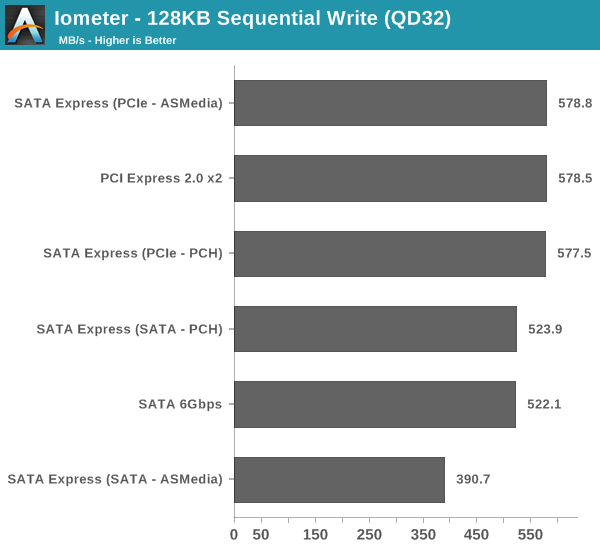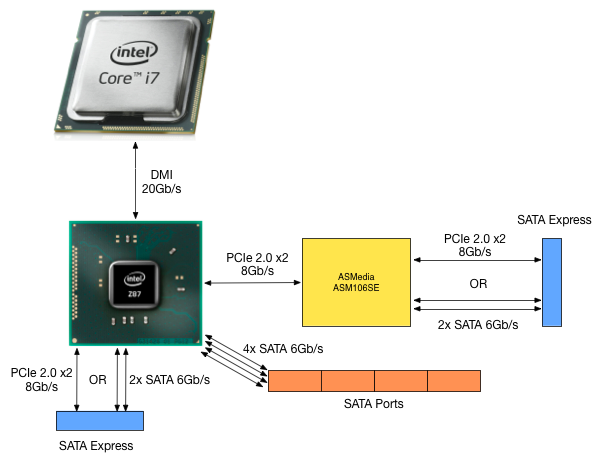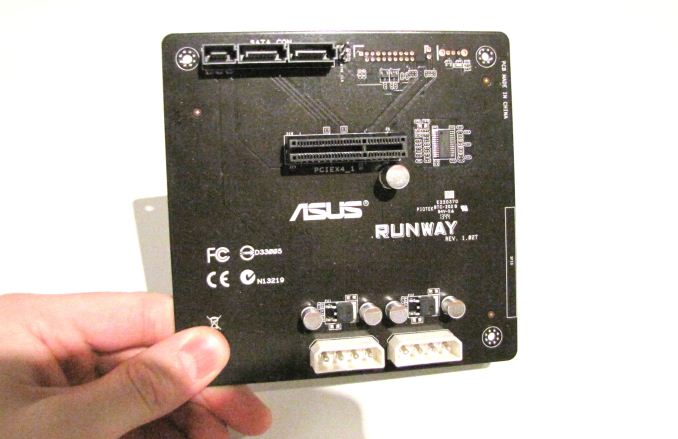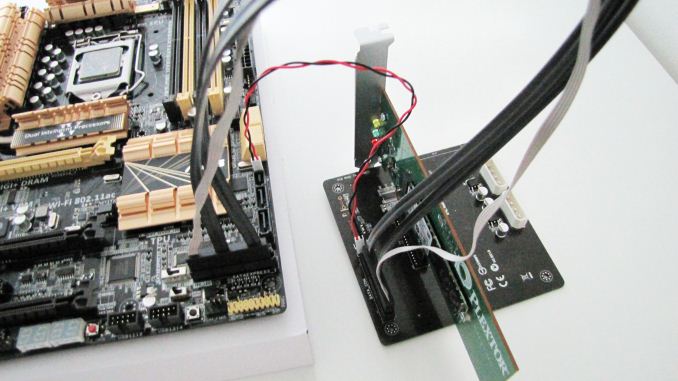Testing SATA Express And Why We Need Faster SSDs
by Kristian Vättö on March 13, 2014 7:00 AM EST- Posted in
- Storage
- SSDs
- Asus
- SATA
- SATA Express
Testing SATA Express
SATAe is not commercially available yet but ASUS sent us a pre-production unit of the SATA Express version of their Z87 Deluxe motherboard along with the necessary peripherals to test SATAe. This is actually the same motherboard as our 2014 SSD testbed but with added SATAe functionality.
| Test Setup | |
| CPU | Intel Core i7-4770K at 3.5GHz (Turbo & EIST enabled, C-states disabled) |
| Motherboard | ASUS Z87 Deluxe SATA Express (BIOS 1707) |
| Chipset | Intel Z87 |
| Chipset Drivers | 9.4.0.1026 |
| Storage Drivers | Intel RST 12.9.0.1001 |
| Memory | Corsair Vengeance DDR3-1866 2x8GB (9-10-9-27 2T) |
| Graphics | Intel HD Graphics 4600 |
| Graphics Drivers | 15.33.8.64.3345 |
| Power Supply | Corsair RM750 |
| OS | Windows 7 Ultimate 64-bit |
Before we get into the actual tests, we would like to thank the following companies for helping us with our 2014 SSD testbed.
- Thanks to Intel for the Core i7-4770K CPU
- Thanks to ASUS for the Z87 Deluxe motherboard
- Thanks to Corsair for the Vengeance 16GB DDR3-1866 DRAM kit, RM750 power supply, Hydro H60 CPU cooler and Carbide 330R case
The ASUS Z87 Deluxe SATA Express has two SATAe ports: one routed from the Platform Controller Hub (PCH) and the other provided by an ASMedia ASM106SE chip. The ASMedia is an unreleased chip, hence there is no information to be found about it and ASUS is very tight-lipped about the whole thing. I'm guessing we are dealing with the same SATA 6Gbps design as other ASM106x chips but with added PCIe pass-through functionality to make the chip suitable for SATA Express.
I did a quick block diagram that shows the storage side of the ASUS SATAe board we have. Basically there are four lanes in total dedicated to SATAe with support for up to two SATAe drives in addition to four SATA 6Gbps devices. Alternatively you can have up to eight SATA 6Gbps devices if neither of the SATAe ports is operating in PCIe mode.
Since there are no SATAe drives available at this point, ASUS sent us a SATAe demo daughterboard along with the motherboard. The daughterboard itself is very simple: it has the same SATAe connector as found in the motherboard, two molex power inputs, a clock cable header, and a PCIe slot.
This is what the setup looks like in action (though as you can see, I took the motherboard out of the case since inside case photos didn't turn out so well with the poor camera I have). The black and red cable is the external clock cable, which is only temporary and won't be needed with a final SATAe board.
The Tests
For testing I used Plextor's 256GB M6e PCIe SSD, which is a PCIe 2.0 x2 SSD with Marvell's new 88SS9183 PCIe controller. Plextor rates the M6e at up to 770MB/s read and 580MB/s write, so we should be capable of reaching the full potential of PCIe 2.0 x2. Additionally I tested the SATA 6Gbps ports with a 256GB OCZ Vertex 450. I used the same sequential 128KB Iometer tests that we use in our SSD reviews but I ramped up the queue depth to 32 to make sure we are looking at a maximum throughput situation.

There is no practical difference between a PCIe slot on the motherboard and PCIe that is routed through SATA Express. I'm a little surprised that there is absolutely no hit in performance (other than a negligible 1.5MB/s that's basically within the margin of error) because after all we are using cabling that should add latency. It seems that SATA-IO has been able to make the cabling efficient enough to transmit PCIe without additional overhead.
As for SATA 6Gbps, the performance is the same as well, which isn't surprising since only the connector is slightly different while electrically everything is the same. With the ASMedia chipset there is ~25-27% reduction in performance but that is inline with the previous ASMedia SATA 6Gbps chipsets I've seen. As I mentioned earlier, I doubt that the ASM106SE brings anything new to the SATA side of the controller and that's why I wasn't expecting more than 400MB/s. Generally you'll only get full SATA bandwidth from an Intel chipset or a higher-end SATA/RAID card.

The same goes for write performance. The only case where you are going to see a difference is if you connect to the ASMedia SATA 6Gbps port. I did run some additional benchmarks (like our performance consistency test) to see if a different workload would yield different results but all my tests showed that SATAe in PCIe mode is as fast as a real PCIe slot, so I'm not going to post a bunch additional graphs showing that the two are equivalent.













131 Comments
View All Comments
Guspaz - Thursday, March 13, 2014 - link
The only justification for why anybody might need something faster than SATA6 seems to be "Uncompressed 4K video is big"...Except nobody uses uncompressed 4K video. Nobody uses it precisely BECAUSE it's so big. 4K cameras all record to compressed formats. REDCODE, ProRes, XAVC, etc. It's true that these still produce a lot of data (they're all intra-frame codecs, which mean they compress each frame independently, taking no advantage of similarities between frames), but they're still way smaller than uncompressed video.
JarredWalton - Thursday, March 13, 2014 - link
But when you edit videos, you end up working with uncompressed data before recompressing, in order to avoid losing quality.willis936 - Thursday, March 13, 2014 - link
The case you described (4K, 12bpc, 24fps) would also take an absolutely monumental amount of RAM. I can't think of using a machine with less than 32GB for that and even then I feel like you'd run out regularly.Guspaz - Thursday, March 13, 2014 - link
Are you rendering from Premiere to uncompressed video as an intermediate format before recompressing in some other tool? If you're working end-to-end with Premiere (or Final Cut) you wouldn't have uncompressed video anywhere in that pipeline. But even if you're rendering to uncompressed 4K video for re-encoding elsewhere, you'd never be doing that to your local SSD, you'd be doing it to big spinning HDDs or file servers. One hour of uncompressed 4K 60FPS video would be ~5TB. Besides, disk transfer rates aren't going to be the bottleneck on rendering and re-encoding uncompressed 4K video.Kevin G - Thursday, March 13, 2014 - link
That highly depends on the media you're working with. 4K consumes far too much storage to be usable in an uncompressed manner. Upto 1.6 GByte/s is needed for uncompressed recording. A 1 TB drive would fill up in a less than 11 minutes.As mentioned by others, losses compression is an option without any reduction in picture quality, though at the expensive of high performance hardware needed for recording and rendering.
JlHADJOE - Thursday, March 13, 2014 - link
You pretty much have to do it during recording.Encoding 4k RAW needs a ton of CPU that you might not have inside your camera, not to mention you probably don't want any lossy compression at that point because there's still a lot of processing work to be done.
JlHADJOE - Friday, March 14, 2014 - link
Here's the Red Epic Dragon, a 6k 100fps camera. It uses a proprietary SSD array (likely RAID 0) for storage:http://www.red.com/products/epic-dragon#features
popej - Thursday, March 13, 2014 - link
"idling (with minimal <0.05W power consumption)"Where did you get this value from? I'm looking at your SSD reviews and clearly see, that idle power consumption is between 0.3 and 1.3W, far away form quoted 0.05W. What is wrong, your assumption here or measurements at reviews? Or maybe you measure some other value?
Kristian Vättö - Thursday, March 13, 2014 - link
<0.05W is normal idle power consumption in a mobile platform with HIPM+DIPM enabled: http://www.anandtech.com/bench/SSD/732We can't measure that in every review because only Anand has the equipment for that. (requires a modified laptop).
dstarr3 - Thursday, March 13, 2014 - link
How does the bandwidth of a single SATAe SSD compare to two SSDs on SATA 6GB/s in Raid0? Risk of failure aside.